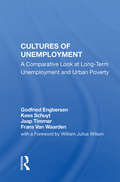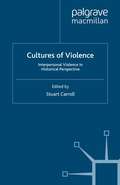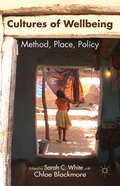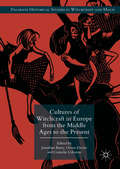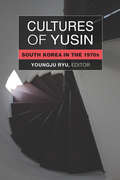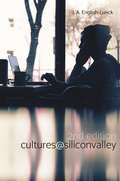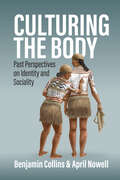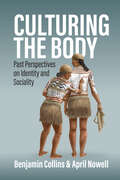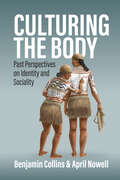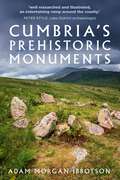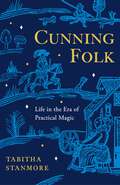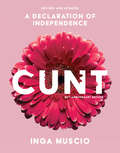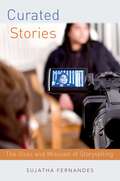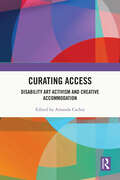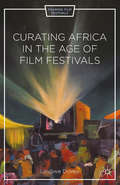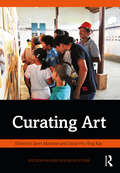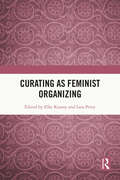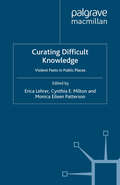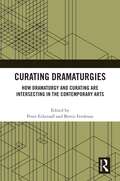- Table View
- List View
Cultures Of Unemployment: A Comparative Look At Long-term Unemployment And Urban Poverty
by Godfried EngbersenThe "cultures" of unemployed people in the United States and abroad are complex, varied and offer explanatory power when analyzed, as they are here, in a systematic way. The authors use case studies and survey data to devise a framework for a better understanding of the effects of welfare state policy on the chronically unemployed. They analyze the
Cultures of Violence: Interpersonal Violence in Historical Perspective
by S. CarrollThinkers and historians have long perceived violence and its control as integral to the very idea of 'Western Civilization'. Focusing on interpersonal violence and the huge role it played in human affairs in the post-medieval West, this timely collection brings together the latest interdisciplinary and historical research in the field.
Cultures of Wellbeing: Method, Place, Policy
by Sarah C. White Chloe BlackmoreThe authors challenge psychological perspectives on happiness and subjective wellbeing. Highlighting the politics of quantitative and qualitative methodologies, case studies across continents explore wellbeing in relation to health, children and youth, migration, economics, religion, family, land mines, national surveys, and indigenous identities.
Cultures of Witchcraft in Europe from the Middle Ages to the Present
by Jonathan Barry Owen Davies Cornelie UsborneThis volume is a collection based on the contributions to witchcraft studies of Willem de Blécourt, to whom it is dedicated, and who provides the opening chapter, setting out a methodological and conceptual agenda for the study of cultures of witchcraft (broadly defined) in Europe since the Middle Ages. It includes contributions from historians, anthropologists, literary scholars and folklorists who have collaborated closely with De Blécourt. Essays pick up some or all of the themes and approaches he pioneered, and apply them to cases which range in time and space across all the main regions of Europe since the thirteenth century until the present day. While some draw heavily on texts, others on archival sources, and others on field research, they all share a commitment to reconstructing the meaning and lived experience of witchcraft (and its related phenomena) to Europeans at all levels, respecting the many varieties and ambiguities in such meanings and experiences and resisting attempts to reduce them to master narratives or simple causal models.The chapter 'News from the Invisible World: The Publishing History of Tales of the Supernatural c.1660-1832' is available open access under a CC BY 4.0 license at link.springer.com.
Cultures of Witchcraft in Europe from the Middle Ages to the Present
by Jonathan Barry Owen Davies Cornelie UsborneThis volume is a collection based on the contributions to witchcraft studies of Willem de Blécourt, to whom it is dedicated, and who provides the opening chapter, setting out a methodological and conceptual agenda for the study of cultures of witchcraft (broadly defined) in Europe since the Middle Ages. It includes contributions from historians, anthropologists, literary scholars and folklorists who have collaborated closely with De Blécourt. Essays pick up some or all of the themes and approaches he pioneered, and apply them to cases which range in time and space across all the main regions of Europe since the thirteenth century until the present day. While some draw heavily on texts, others on archival sources, and others on field research, they all share a commitment to reconstructing the meaning and lived experience of witchcraft (and its related phenomena) to Europeans at all levels, respecting the many varieties and ambiguities in such meanings and experiences and resisting attempts to reduce them to master narratives or simple causal models.The chapter 'News from the Invisible World: The Publishing History of Tales of the Supernatural c.1660-1832' is available open access under a CC BY 4.0 license at link.springer.com.
Cultures of Yusin: South Korea in the 1970s (Perspectives On Contemporary Korea)
by Youngju RyuCultures of Yusin examines the turbulent and yet deeply formative years of Park Chung Hee’s rule in South Korea, focusing on the so-called Yusin era (1972–79). Beginning with the constitutional change that granted dictatorial powers to the president and ending with his assassination, Yusin was a period of extreme political repression coupled with widespread mobilization of the citizenry towards the statist gospel of modernization and development. While much has been written about the political and economic contours of this period, the rich complexity of its cultural production remains obscure. This edited volume brings together a wide range of scholars to explore literature, film, television, performance, music, and architecture, as well as practices of urban and financial planning, consumption, and homeownership. Examining the plural forms of culture’s relationship to state power, the authors illuminate the decade of the 1970s in South Korea and offer an essential framework for understanding contemporary Korean society.
Cultures@SiliconValley: Second Edition
by J.A. English-LueckSince the initial publication of Cultures@SiliconValley fourteen years ago, much has changed in Silicon Valley. The corporate landscape of the Valley has shifted, with tech giants like Google, Facebook, LinkedIn, and Twitter vying for space with a halo of applications that connect people for work, play, romance, and education. Contingent labor has been catalyzed by ubiquitous access to the Internet on smartphones, enabling ride-sharing services like Uber and Lyft and space-sharing apps like Airbnb. Entrepreneurs compete for people's attention and screen time. Alongside these changes, daily life for all but the highest echelon has been altered by new perceptions of scarcity, risk, and shortage. Established workers and those new to the workforce try to adjust. The second edition of Cultures@SiliconValley brings the story of technological saturation and global cultural diversity in this renowned hub of digital innovation up to the present. In this fully updated edition, J. A. English-Lueck provides readers with a host of new ethnographic stories, documenting the latest expansions of Silicon Valley to San Francisco and beyond. The book explores how changes in technology, especially as mobile phones make the Internet accessible everywhere, impact work, family, and community life. The inhabitants of Silicon Valley illustrate in microcosm the social and cultural identity of the future.
Culturing the Body: Past Perspectives on Identity and Sociality
by Benjamin Collins and April NowellThe human body is both the site of lived experiences and a means of communicating those experiences to a diverse audience. Hominins have been culturing their bodies, that is adding social and cultural meaning through the use pigments and objects, for over 100,000 years. There is archaeological evidence for practices of adornment of the body by late Pleistocene and early Holocene hominins, including personal ornaments, clothing, hairstyles, body painting, and tattoos. These practices have been variously interpreted to reflect differences such as gender, status, and ethnicity, to attract or intimidate others, and as indices of a symbolically mediated self and personal identity. These studies contribute to a novel and growing body of evidence for diversity of cultural expression in the past, something that is a hallmark of human cultures today.
Culturing the Body: Past Perspectives on Identity and Sociality
by Benjamin Collins April NowellThe human body is both the site of lived experiences and a means of communicating those experiences to a diverse audience. Hominins have been culturing their bodies, that is adding social and cultural meaning through the use pigments and objects, for over 100,000 years. There is archaeological evidence for practices of adornment of the body by late Pleistocene and early Holocene hominins, including personal ornaments, clothing, hairstyles, body painting, and tattoos. These practices have been variously interpreted to reflect differences such as gender, status, and ethnicity, to attract or intimidate others, and as indices of a symbolically mediated self and personal identity. These studies contribute to a novel and growing body of evidence for diversity of cultural expression in the past, something that is a hallmark of human cultures today.
Culturing the Body: Past Perspectives on Identity and Sociality
The human body is both the site of lived experiences and a means of communicating those experiences to a diverse audience. Hominins have been culturing their bodies, that is adding social and cultural meaning through the use pigments and objects, for over 100,000 years. There is archaeological evidence for practices of adornment of the body by late Pleistocene and early Holocene hominins, including personal ornaments, clothing, hairstyles, body painting, and tattoos. These practices have been variously interpreted to reflect differences such as gender, status, and ethnicity, to attract or intimidate others, and as indices of a symbolically mediated self and personal identity. These studies contribute to a novel and growing body of evidence for diversity of cultural expression in the past, something that is a hallmark of human cultures today.
Cumbria's Prehistoric Monuments
by Adam Morgan IbbotsonCumbria is a land built from stone. Whether it is Hadrian's Wall, Kendal Castle or the beautiful fells of the Lake District – for thousands of years people have found a certain elegance and utility in stone. Nestled amongst these common relics are a multitude of massive stone monuments, built over 3,000 years before British shores were ever touched by Roman sandals. Cumbria’s 'megalithic' monuments are among Europe's greatest and best-preserved ancient relics but are often poorly understood and rarely visited.Cumbria’s Prehistoric Monuments aims to dispel the idea that these stones are merely ‘mysterious’. Instead, within this book you will find credible answers, using up-to-date research, excavation notes, maps and diagrams to explore one of Britain's richest archaeological landscapes. Featuring stunning original photography and newly illustrated diagrams of every megalithic site in the county, Adam Morgan Ibbotson invites you to take a journey into a land sculpted by ancient hands.
Cunning Folk: Life in the Era of Practical Magic
by Tabitha Stanmore‘A brilliant book, written with wit and vigour’ MALCOLM GASKILL‘Absolutely fascinating’ IAN MORTIMERTabitha Stanmore transports us to a time when magic was used to navigate life's challenges and solve problems of both trivial and deadly importance.It’s 1600 and you’ve lost your precious silver spoons, or maybe they’ve been stolen. Perhaps your child has a fever. Or you’re facing trial. Maybe you’re looking for love or escaping a husband. What do you do?In medieval and early modern Europe, your first port of call might have been cunning folk: practitioners of ‘service magic’. Neither feared (like witches), nor venerated (like saints), these people were essential: a ubiquitous presence at a time when the supernatural was surprisingly mundane and a cherished everyday resource.We meet lovelorn widows, selfless healers and renegade monks; we listen in on Queen Elizabeth I’s astrology readings and track treasure hunters who try to keep peace with fairies. Much like us, premodern people lived in bewildering times, buffeted by forces beyond their control – and their faith in magic has much to teach us about how we accommodate ourselves to the irrational in our allegedly enlightened lives today.Charming in every sense of the word, Cunning Folk is an immersive reconstruction of a bygone world and a thought-provoking commentary on the beauty and bafflement of being human.
Cunt, 20th Anniversary Edition: A Declaration Of Independence (Live Girls Ser.)
by Inga MuscioAn ancient title of respect for women, the word "cunt" long ago veered off this noble path. Inga Muscio traces the road from honor to expletive, giving women the motivation and tools to claim "cunt" as a positive and powerful force in their lives. With humor and candor, she shares her own history as she explores the cultural forces that influence women's relationships with their bodies. Sending out a call for every woman to be the Cuntlovin' Ruler of Her Sexual Universe, Muscio stands convention on its head by embracing all things cunt-related. This updated edition features a new foreword by Betty Dodson, an introduction by Derrick Jensen, a new afterword by the author and an updated and expanded resource section.
Curated Stories: The Uses and Misuses of Storytelling (Oxford Studies in Culture and Politics)
by Sujatha FernandesStorytelling has proliferated today, from TED Talks and Humans of New York to a plethora of story-coaching agencies and consultants. Heartbreaking accounts of poverty, mistreatment, and struggle may move us deeply. But what do they move us to do? And what are the stakes in the crafting and use of storytelling? In Curated Stories, Sujatha Fernandes considers the rise of storytelling alongside the broader shift to neoliberal, free-market economies. She argues that stories have been reconfigured to promote entrepreneurial self-making and restructured as easily digestible soundbites mobilized toward utilitarian ends. Fernandes roams the globe and returns with stories from the Afghan Women's Writing Project, the domestic workers movement and the undocumented student Dreamer movement in the United States, and the Misión Cultura project in Venezuela. She shows how the conditions under which certain stories are told, the tropes through which they are narrated, and the ways in which they are responded to may actually disguise the deeper contexts of global inequality. Curated stories shift the focus away from structural problems and defuse the confrontational politics of social movements. Not just a critical examination of the contemporary use of narrative and its wider impact on our collective understanding of pressing social issues, Curated Stories also explores how storytelling might be reclaimed to allow for the complexity of experience to be expressed in pursuit of transformative social change.
CURATED STORIES OXSCP C: The Uses and Misuses of Storytelling (Oxford Studies in Culture and Politics)
by Sujatha FernandesStorytelling has proliferated today, from TED Talks and Humans of New York to a plethora of story-coaching agencies and consultants. Heartbreaking accounts of poverty, mistreatment, and struggle may move us deeply. But what do they move us to do? And what are the stakes in the crafting and use of storytelling? In Curated Stories, Sujatha Fernandes considers the rise of storytelling alongside the broader shift to neoliberal, free-market economies. She argues that stories have been reconfigured to promote entrepreneurial self-making and restructured as easily digestible soundbites mobilized toward utilitarian ends. Fernandes roams the globe and returns with stories from the Afghan Women's Writing Project, the domestic workers movement and the undocumented student Dreamer movement in the United States, and the Misión Cultura project in Venezuela. She shows how the conditions under which certain stories are told, the tropes through which they are narrated, and the ways in which they are responded to may actually disguise the deeper contexts of global inequality. Curated stories shift the focus away from structural problems and defuse the confrontational politics of social movements. Not just a critical examination of the contemporary use of narrative and its wider impact on our collective understanding of pressing social issues, Curated Stories also explores how storytelling might be reclaimed to allow for the complexity of experience to be expressed in pursuit of transformative social change.
Curating (Ethnografische Perspektiven auf das östliche Europa #7)
by Philipp Schorch Daniel HabitIn which ways are environments (post-)socialist and how do they come about? How is the relationship between the built environment, memory, and debates on identity enacted? What are the spatial, material, visual, and aesthetic dimensions of these (post-)socialist enactments or interventions? And how do such (post-)socialist interventions in environments become (re)curated? By addressing these questions, this volume releases ›curation‹ from its usual museological framing and carries it into urban environments and private life-worlds, from predominantly state-sponsored institutional settings with often normative orientations into spheres of subjectification, social creativity, and material commemorative culture.
Curating Access: Disability Art Activism and Creative Accommodation
by Amanda CachiaThis book is an interdisciplinary collection of twenty-four essays which critically examine contemporary exhibitions and artistic practices that focus on conceptual and creative aspects of access. Oftentimes exhibitions tack on access once the artwork has already been executed and ready to be installed in the museum or gallery. But what if the artists were to ponder access as an integral and critical part of their artwork? Can access be creative and experimental? And furthermore, can the curator also fold access into their practice, while working collaboratively with artists, considering it as a theoretical and practical generative force that seeks to make an exhibition more engaging for a wider diversity of audiences? This volume includes essays by a growing number of artists, curators, and scholars who ponder these ideas of ad-hoc, experimental and underground approaches within exhibition-making and artistic practices. It considers how, through these nascent exhibition models and art practices, enhanced experiences of access in the museum can be a shared responsibility amongst museum workers, curators, and artists, in tandem with the public, so that access becomes a zone of intellectual and creative "accommodation," rather than strictly a discourse on policy. The book provides innovative case studies which provide a template for how access might be implemented by individuals, artists, curators, museum administrators and educators given the growing need to offer as many modalities of access as possible within cultural institutions. This book shows that anyone can be a curator of access and demonstrates how to approach access in a way that goes beyond protocol and policy. It will thus be of interest to students and scholars engaged in the study of museums, art history and visual culture, disability, culture, and communication.
Curating Access: Disability Art Activism and Creative Accommodation
by Amanda CachiaThis book is an interdisciplinary collection of twenty-four essays which critically examine contemporary exhibitions and artistic practices that focus on conceptual and creative aspects of access. Oftentimes exhibitions tack on access once the artwork has already been executed and ready to be installed in the museum or gallery. But what if the artists were to ponder access as an integral and critical part of their artwork? Can access be creative and experimental? And furthermore, can the curator also fold access into their practice, while working collaboratively with artists, considering it as a theoretical and practical generative force that seeks to make an exhibition more engaging for a wider diversity of audiences? This volume includes essays by a growing number of artists, curators, and scholars who ponder these ideas of ad-hoc, experimental and underground approaches within exhibition-making and artistic practices. It considers how, through these nascent exhibition models and art practices, enhanced experiences of access in the museum can be a shared responsibility amongst museum workers, curators, and artists, in tandem with the public, so that access becomes a zone of intellectual and creative "accommodation," rather than strictly a discourse on policy. The book provides innovative case studies which provide a template for how access might be implemented by individuals, artists, curators, museum administrators and educators given the growing need to offer as many modalities of access as possible within cultural institutions. This book shows that anyone can be a curator of access and demonstrates how to approach access in a way that goes beyond protocol and policy. It will thus be of interest to students and scholars engaged in the study of museums, art history and visual culture, disability, culture, and communication.
Curating Africa in the Age of Film Festivals (Framing Film Festivals)
by L. DoveyTracing the history of Africa's relationship to film festivals and exploring the festivals' impact on the various types of people who attend festivals (the festival experts, the ordinary festival audiences, and the filmmakers), Dovey reveals what turns something called a "festival" into a "festival experience" for these groups.
Curating Art (Leicester Readers in Museum Studies)
by Janet Marstine Oscar Ho Hing KayCurating Art provides insight into some of the most socially and politically impactful curating of historical and contemporary art since the late 1990s. It offers up a museological framework for understanding watershed developments of curating in art museums. Representing the plurality of theory and practice around the expanded field of relational curating, the book focuses on curating that prioritises the quality of relationships between people and objects, between institutions and people and among people. It has wide international breadth, with particularly strong representation in East and Southeast Asia, including four papers never before translated into English. This Asian cluster illuminates the globalisation of the field and challenges dichotomies of East and West while acknowledging distinctions within specific, but often transnational, cultural spheres. The compelling philosophical perspectives and case studies included within Curating Art will be of interest to students and researchers studying curating, exhibition development and art museums. The book will also inspire current and emerging curators to pose challenging but important questions about their own practice and the relationships that this work sustains.
Curating Art (Leicester Readers in Museum Studies)
by Janet Marstine Oscar Ho Hing KayCurating Art provides insight into some of the most socially and politically impactful curating of historical and contemporary art since the late 1990s. It offers up a museological framework for understanding watershed developments of curating in art museums. Representing the plurality of theory and practice around the expanded field of relational curating, the book focuses on curating that prioritises the quality of relationships between people and objects, between institutions and people and among people. It has wide international breadth, with particularly strong representation in East and Southeast Asia, including four papers never before translated into English. This Asian cluster illuminates the globalisation of the field and challenges dichotomies of East and West while acknowledging distinctions within specific, but often transnational, cultural spheres. The compelling philosophical perspectives and case studies included within Curating Art will be of interest to students and researchers studying curating, exhibition development and art museums. The book will also inspire current and emerging curators to pose challenging but important questions about their own practice and the relationships that this work sustains.
Curating as Feminist Organizing
by Elke Krasny Lara PerryWhat makes curating feminist organizing? How do curators relate to contemporary feminist concerns in their local conditions and the globalized artworld? The book brings together twenty curatorial case studies from diverse regions of the globe. Reflecting their own curatorial projects or analyzing feminist-inspired exhibitions, the authors in this book elaborate feminist curating as that which is inspired to challenge gender politics not only within but also beyond the doors of the museum and gallery. Connecting their wider feminist politics to their curatorial practices, the book provides case studies of curatorial practice that address the legacies of racialized and ethnic violence, including colonialism; which seek to challenges the state's regulation of citizenship and sexuality; and which realize the drive for economic justice in the organizations and roles in which curators work. The settings in which this work is done range from university art galleries to artist-run spaces and educational or activist programmes. This collection will be enjoyed by those studying and researching curating, exhibitions, socially and ecologically engaged contemporary art practices, and feminist transnational movements in diverse geographic contexts. The essays are of relevance to practicing curators, critical cultural practitioners, and artists.
Curating as Feminist Organizing
by Elke Krasny Lara PerryWhat makes curating feminist organizing? How do curators relate to contemporary feminist concerns in their local conditions and the globalized artworld? The book brings together twenty curatorial case studies from diverse regions of the globe. Reflecting their own curatorial projects or analyzing feminist-inspired exhibitions, the authors in this book elaborate feminist curating as that which is inspired to challenge gender politics not only within but also beyond the doors of the museum and gallery. Connecting their wider feminist politics to their curatorial practices, the book provides case studies of curatorial practice that address the legacies of racialized and ethnic violence, including colonialism; which seek to challenges the state's regulation of citizenship and sexuality; and which realize the drive for economic justice in the organizations and roles in which curators work. The settings in which this work is done range from university art galleries to artist-run spaces and educational or activist programmes. This collection will be enjoyed by those studying and researching curating, exhibitions, socially and ecologically engaged contemporary art practices, and feminist transnational movements in diverse geographic contexts. The essays are of relevance to practicing curators, critical cultural practitioners, and artists.
Curating Difficult Knowledge: Violent Pasts in Public Places (Palgrave Macmillan Memory Studies)
by Erica Lehrer Cynthia E. Milton Monica Eileen PattersonThis volume inscribes an innovative domain of inquiry, bringing museum and heritage studies to bear on questions of transitional justice, memory and post-conflict reconciliation. As practitioners, artists, curators, activists and academics, the contributors explore the challenges of bearing witness to past conflicts.
Curating Dramaturgies: How Dramaturgy and Curatorial Practices are Intersecting in the Contemporary Arts
by Peter Eckersall Bertie FerdmanCurating Dramaturgies investigates the transformation of art and performance and its impact on dramaturgy and curatorship. Addressing contexts and processes of the performing arts as interconnecting with visual arts, this book features interviews with leading curators, dramaturgs and programmers who are at the forefront of working in, with, and negotiating the daily practice of interdisciplinary live arts. The book offers a view of praxis that combines perspectives on theory and practice and looks at the way that various arts institutions, practitioners and cultural agents have been working to change the way that art and performance have developed and experienced by spectators in the last decade. Curating Dramaturgies argues that cultural producers and scholars are becoming more cognizant of this overlapping and transforming field. The introductory essay by the editors explores the rise of interdisciplinary live arts and its ramifications in cultural and political terms. This is further elaborated in the interviews with 15 diversely placed arts professionals who are at the forefront of rethinking and consolidatingthe ever-evolving field of the visual arts and performance.
